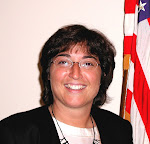


Up earlier than normal for a bus ride from Vukovar (where we docked) to Osijek –about ½ hour away. Marina was our guide; a strong-willed, opinionated young woman who wants to become a lawyer, judge and mayor. She explained how difficult it was for the older generation to accept Serbs and Croats living together. The younger generation is more accepting. The Croats have lived there since the 7th century.
Croatia has 20 counties and the capital is Zagreb. Total population is 4 million. 95% are Roman Catholic.
Tito opened the borders in the ‘60s. He gave women the right to vote and women were given the same opportunities as men for employment. They make brandy out of the many fruits in their fertile region. There are still mines in many fields and it will take at least another ten years to clear the areas. The children grow up learning not to run out in fields. They pay 23% VAT. Children go to school in shifts - -a morning shift from 8-1 and then from 1:30-7. They pay for their books and public bus pass to get to school. Fewer and fewer children are being born as the cost to raise them is too high. Books cost approx. $150-300 a year. Average salary is $1000/month. They are known to enjoy life (and nightlife) and there are many night clubs and cafes.
Osijek is in the far north-eastern corner of Croatia on the Drava River. We walked by the Tvrdja fortress, on the Drava River, and then had a drink (I tried the Croatian beer) by the river at a new Hotel Osijek. Mom and I walked to the Urania movie theatre that had a façade like a whale’s tusks. The Turks were here in the Middle Ages and built one of the wonders of the world – the longest wooden bridge – which was approx. 5 miles long over the river and marsh lands around the 1500s. We toured the neo-Gothic Cathedral of St. Peter and St. Paul. Osijek also suffered during the 9 month bombardment of the Yugoslav war and there are scars around the city with caved in roofs and dilapidated buildings. Under the main square, they had a shopping mall and we walked quickly through the shops. Women seem to be wearing boots – high and short heels and very decorative. We’ll see if they come to the USA.
We walked with our new guide, Lorena around Vukovar, a once beautiful town. Until 1991 it was a prosperous town with a quaint Baroque center and a successful manufacturing industry of Borovo shoes and vegetables. There are many large grain silos in the flat plains surrounding the city. However, due to its proximity to the Serbian border there was a war between the Croats and Serbs for 90 days that left the city in ruin. 30,000 houses were destroyed. Bullet holes in the doors and building walls and destroyed houses and businesses are still littered throughout the streets. They are slowly rebuilding and renovating but there is at least one building on each street that needs renovation. The unemployment is 32% and many young people have not returned to their city after being educated elsewhere since there are no jobs. We walked to see the ruined Eltz Palace (owned by a land owning family) and the new Hotel Lav, the Franciscan Monastery and the water tower, which will not be renovated and will remain the symbol of what the city has survived. Mr. Lavoslav Ruzicka, won the Nobel prize in 1939 for his work in chemistry, and we passed his residence. We saw the Chapel of St. Roka, where they prayed to survive the plague.
Ruins from 3000BC were found down river, including proof of copper processing. Romans lived here and the area is known for their vineyards. They also sell a “frozen” wine where the berries are picked at -5 degrees Celsius to make a sweeter wine. Some of their wine was served when Queen Elizabeth II was crowned. Croatia became independent in 1991.
